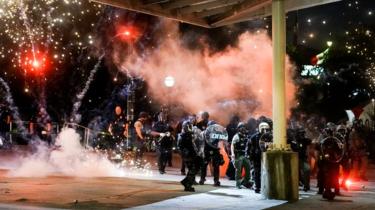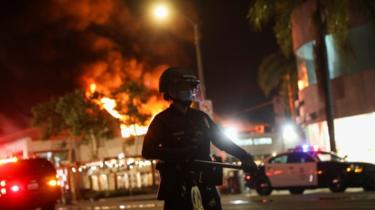|
Getting your Trinity Audio player ready...
|
Curfews have been ordered in cities across the US to try to stem unrest sparked by the death of a black man in police custody.
Largely peaceful protests later turned violent in many areas, with cars and buildings set alight and riot police using tear gas and rubber bullets.
President Donald Trump urged “healing” over the death of George Floyd but said he could not allow mobs to dominate.
An ex-policeman has been charged with murdering Mr Floyd, 46, in Minneapolis.
Derek Chauvin, 44 and white, is due to appear in court on Monday.
In video footage, Mr Chauvin can be seen kneeling on Mr Floyd’s neck for several minutes on Monday. Mr Floyd repeatedly says that he is unable to breathe.
The last 30 minutes of George Floyd’s life
In pictures: Protests turn violent
Why has a US city gone up in flames?
Three other officers present at the time have also since been sacked.
The Floyd case has reignited US anger over police killings of black Americans. It follows the high-profile cases of Michael Brown in Ferguson, Eric Garner in New York and others that have driven the Black Lives Matter movement.
But for many it also reflects years of frustration over socioeconomic inequality and segregation, not least in Minneapolis itself.
What’s the latest on the protests?
Large demonstrations have taken place in at least 30 cities across the US.
One of the cities worst affected by unrest is Los Angeles. California Governor Gavin Newsom declared a state of emergency in the city and activated the National Guard – the reserve military force that can be called on by the US president or state governors to intervene in domestic emergencies.
The entire city is under a 20:00 to 05:30 curfew. Numerous shops have been looted, including on the famous retail avenues, Melrose and Fairfax, while overhead footage showed fires burning. Earlier police fired rubber bullets and hit protesters with batons. Hundreds of arrests have been made.
Mayor Eric Garcetti said this was “the heaviest moment I’ve experienced” since the riots in 1992 that were sparked by the acquittal of police over the beating of Rodney King.
In New York, video showed a police car driving into a crowd of protesters. Mayor Bill de Blasio said the situation was not started by the officers, but Congress Representative Alexandria Ocasio-Cortez said his comments were unacceptable and he should not be making excuses for the officers.
Chicago Mayor Lori Lightfoot imposed a 21:00 to 06:00 curfew until further notice, saying she was “disgusted” at the violence.
“I’ve seen protesters hurl projectiles at our police department… bottles of water, urine and Lord knows what else,” she said.
In Atlanta, protesters remained on the streets after the curfew began, damaging property and vehicles. Dozens of arrests were made.
One city that has seen less violence is where George Floyd died. Some 700 National Guard officers are aiding police in Minneapolis and they acted quickly to enforce the curfew imposed there. The Star Tribune said the action had so far headed off the unrest of the previous night.
For the second day running, a large crowd of protesters taunted National Guard officers outside the White House in Washington, DC. If they had breached the fence, President Trump said they would have been “greeted with the most vicious dogs, and most ominous weapons, I have ever seen”.
Indianapolis was one of the cities that had seen peaceful protests during the day turn violent later. At least one shooting death has occurred, but police said no officers had discharged weapons.
In under-curfew Philadelphia, 13 police officers were hurt and at least 35 arrests made as stores were looted, police cars torched and buildings defaced.
Overnight curfews have also been declared in Philadelphia, Miami, Portland and Louisville, among other cities, although many were simply ignored.
San Francisco is the latest to impose a curfew, announced by Mayor London Breed for 20:00 local time on Sunday, after looting and violence.
What has the president said?
On Saturday evening, Mr Trump said that Mr Floyd’s death had “filled Americans with horror, anger and grief”.
“I stand before you as a friend and ally to every American seeking peace,” he said in a televised address from Cape Canaveral in Florida, following the launch into orbit of two Nasa astronauts by billionaire Elon Musk’s SpaceX company.
The president denounced the actions of “looters and anarchists”, accusing them of dishonouring the memory of Mr Floyd. What was needed, he said, was “healing not hatred, justice not chaos”.
“I will not allow angry mobs to dominate – won’t happen,” he added.
Mr Trump has blamed the mayor of Minneapolis – a Democrat – for failing to control the protests, which are the worst since the president took office.
He said that if the violence was not brought under control, the National Guard would do the job.
The president’s Democratic Party rival, Joe Biden, has accused him of giving oxygen to bigotry and said those responsible for Mr Floyd’s death must be held accountable.
But he also condemned rioting, saying: “Protesting such brutality is right and necessary. But burning down communities and needless destruction is not.”
What happened to George Floyd?
On Monday night, police received a phone call from a neighbourhood grocery store alleging that George Floyd had paid with a counterfeit $20 note.
Officers responded and were attempting to put him in a police vehicle when he dropped to the ground, telling them he was claustrophobic.
According to police, he physically resisted officers and was handcuffed. Video of the incident does not show how the confrontation started.
With Mr Chauvin’s knee on his neck, Mr Floyd can be heard saying “please, I can’t breathe” and “don’t kill me”.
According to a preliminary autopsy by the county medical examiner, the police officer had his knee on Mr Floyd’s neck for eight minutes and 46 seconds – almost three minutes of which was after Mr Floyd became non-responsive.
Media captionMinnesota governor on George Floyd death: ‘Thank God a young person had a camera to video it’
Nearly two minutes before Mr Chauvin removed his knee the other officers checked Mr Floyd’s right wrist for a pulse and were unable to find one. He was taken to hospital and pronounced dead around an hour later.
The preliminary autopsy, included in the criminal complaint against Mr Chauvin, did not find evidence of “traumatic asphyxia or strangulation”.
The medical examiner noted Mr Floyd had underlying heart conditions and the combination of these, “potential intoxicants in his system” and being restrained by the officers “likely contributed to his death”.
Mr Chauvin was charged on Friday with third-degree murder and second-degree manslaughter over his role in Mr Floyd’s death.
Mr Floyd’s family said they wanted a more serious, first-degree murder charge as well as the arrest of the three other officers involved.
Hennepin County Prosecutor Mike Freeman said he “anticipates charges” for the other officers but would not offer more details.
Source: BBC






